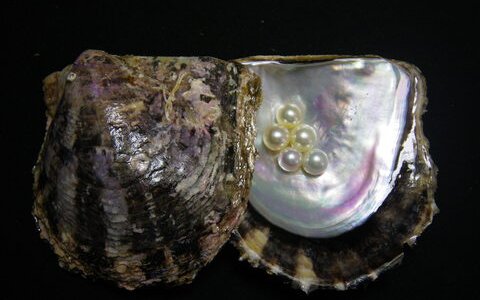Supported by grants from the Project of the Bio-oriented Technology Research Advancement Institution, a special scheme project on advanced research and development for next-generation technology, researchers from Okinawa Institute of Science and Technology (OIST), K. MIKIMOTO & CO., LTD, Pearl Research Institute, and Japan Fisheries Research and Education Agency, have constructed a high-quality, chromosome-scale genome of pearl oysters.
In the early 1990s, the pearl oyster farming industry in Japan amounted to JPY 88 (USD 630 million) but the production capacity dropped from 70 tonnes per year to 20 in the past two decades. Mainly caused by disease spreading, the economic losses suffered by the sector highlighted the importance to finding out more information about the pearl oyster’s underlying genetics, especially on resilient strains.
By using advanced technology, researchers from the Okinawa Institute of Science and Technology (OIST), constructed a high-quality, chromosome-scale pearl oyster’s genome for two sets of chromosomes, revealing unexpected diversity of the gene repertoire within an individual and a variety of genes responsible for immunity. According to the researchers, these findings in pearl oyster’s genome could enable the development of resilient oyster strains.
“It’s very important to establish the genome,” said Takeshi Takeuchi, researcher at OIST’s Marine Genomics Unit. “Genomes are the full set of an organism’s genes—many of which are essential for survival. With the complete gene sequence, we can do many experiments and answer questions around immunity and how the pearls form.”
In 2012, Dr. Takeuchi and his collaborators published a draft genome of the Japanese pearl oyster, Pinctada fucata, which was one of the first genomes assembled of a mollusk. They continued genome sequencing in order to establish a higher quality, chromosome-scale genome assembly.
Traditionally, when a genome is sequenced, the researchers merge the pair of chromosomes together. This works well for laboratory animals, which normally have almost identical genetic information between the pair of chromosomes. But for wild animals, where a considerable number of variants in genes exist between chromosome pairs, this method leads to a loss of information.
In this study, the researchers decided not to merge the chromosomes when sequencing the genomes. Instead, they sequenced both sets of chromosomes—a method that is very uncommon. In fact, it’s probably the first research focused on marine invertebrates to use this method. Takeuchi reconstructed all 28 chromosomes and found key differences between the two chromosomes of one pair—chromosome pair 9. Notably, many of these genes were related to immunity.
“Different genes on a pair of chromosomes is a significant find because the proteins can recognize different types of infectious diseases,” said Takeuchi. “It is important to maintain the genome diversity in aquaculture populations,”
Takeuchi pointed out that when the animal is cultured, there is often a strain that has a higher rate of survival or produces more beautiful pearls. The farmers often breed two animals with this strain but that leads to inbreeding and reduces genetic diversity. The researchers found that after three consecutive inbreeding cycles, the genetic diversity was significantly reduced. If this reduced diversity occurs in the chromosome regions with genes related to immunity, it can impact the immunity of the animal.
Reference:
A high-quality, haplotype-phased genome reconstruction reveals unexpected haplotype diversity in a pearl oyster. Takeshi Takeuchi, Yoshihiko Suzuki, Shugo Watabe, Kiyohito Nagai, Tetsuji Masaoka, Manabu Fujie, Mayumi Kawamitsu, Noriyuki Satoh, Eugene W. Myers. DNA Research. DOI:10.1093/dnares/dsac035













